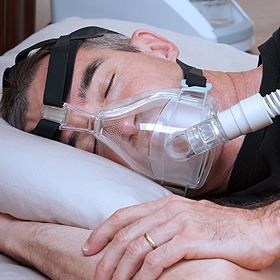Obstructive sleep apnea (OSA) is the inability to oxygenate properly during sleep due to obstruction. This leads to disrupted sleep and low oxygen levels. This can lead to multiple medical problems with a significant increased risk of high blood pressure and heart disease. The obstruction occurs when the tongue falls back against the back of the throat, blocking the upper airway, stopping airflow. This leads to a decrease in the oxygen levels, which leads to restless sleep.
As the cycles repeat throughout the night this can lead to very serious heart problems, excessive daytime sleepiness, loss of concentration and depression. Obstructive Sleep Apnea is a very serious condition that needs careful attention and treatment. Most major medical plans offer coverage for diagnosis and treatment.

Sleep Studies and Initial Treatment
The severity of the patient’s condition is assessed by the use of a sleep study. During the sleep study the number of episodes is observed and the patient is categorized in one of 3 categories. In most sleep instances the patient is also placed on a CPAP (Continuous Positive Airway Pressure) machine to assess if any improvement is noted with the use of a CPAP.
The initial treatment typically involves weight loss and life style changes, as well as the use of a CPAP machine. Although successful, the most common problem with the CPAP machine is the inability of the patient to tolerate the treatment. Due to the detrimental effects of OSA on patients, surgical procedures are sometimes recommended.
Using techniques that Oral and Maxillofacial Surgeons have used for many years in the treatment of facial deformities, most patient are candidates for Jaw repositioning surgery. In order to treat the obstruction, the patient’s upper and lower jaws are repositioned to increase the size of the airway.
During your consultation with Dr. Duraini a detailed history and physical is obtained. Dr. Duraini will also assess the anatomic relationships in the maxillofacial region. At Texas Maxillofacial Surgery we can obtain a 3-D scan, allowing Dr. Duraini to plan these surgeries with precision and accuracy. This reduces the complexity of the surgery and the time under anesthesia. This procedure is done in the hospital under general anesthesia and requires a short hospital stay post-operatively.



